Table of Contents
What is Seasoning of Timber?
Removal of moisture from timber so as to be in equilibrium with the moisture in surrounding atmospheric condition, where timber is likely to be used is called the seasoning of timber.
In other words, seasoning of timber means getting rid of the sap and moisture from it. After seasoning has been done timber is not liable to be decayed.
After seasoning, the timber becomes dry, hard, light in weight, less in bulk and resilient.
Purpose of Seasoning of Timber
The seasoning of timber is performed to achieve the following purpose:
- To impart hardness, stiffness, strength and better electrical resistance to timber.
- To make timber easily workable and facilitate operations during conversion.
- To maintain the shape and size of the component of the timber article which is expected to remain unchanged in shape.
- To reduce the tendency of timber to crack, warp and shape.
- To make timber safe from the attack of fungi and insects.
- To make timber suitable for glueing i.e. effectively joining two members of timbers of timber with aid of glue.
- To allow timber to burn readily when used as fuel.
- To make timber fit for receiving treatment of paints, varnish, preservatives etc.
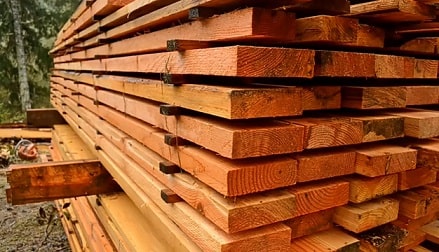
Also, Read – Difference Between Veneer and Laminate
Methods of Seasoning
There are different methods of seasoning like
- Natural Seasoning
- Artificial Seasoning
Natural Seasoning
There are two methods of natural seasoning.
Air Seasoning
It is the best method of seasoning. In this method, water or moisture is driven out from the timber by a very slow process of evaporation. The object of seasoning is to ensure regular and uniform drying all throughout the timber.
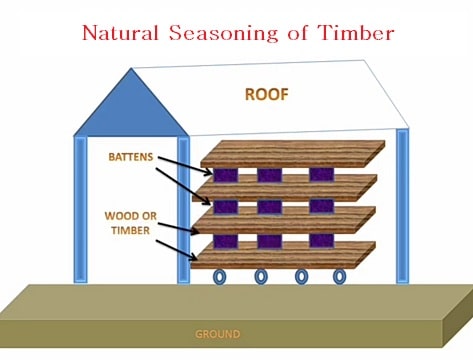
Water Seasoning
In this method logs are kept immersed in ponds or in running streams with the root ends upstream for three to four weeks. Maximum sap is washed out by this process. The logs should be kept entirely down under water by chaining them. Now after that, these logs are kept under the shed for free air circulation.

Advantages of Natural Seasoning of Timber
- Depending upon the climatic conditions, the moisture content of wood can be brought to about 10 to 20 %.
- It does not require skilled supervision.
- It is uneconomical to provide artificial seasoning to timber sections thicker than 100 mm, as such sections dry very slowly, hence such thicker timber sections are usually seasoned by the process of air seasoning.
- This method of seasoning timber is cheap and simple.
Artificial Seasoning
There are different methods of artificial seasoning.
MC Neills Seasoning
This is to be the best method of artificial seasoning, as it has no adverse effect on the appearance and strength of the timber.
The time required varies with the nature of timber, usually 15 days to two months. Timber seasoned by this method is rendered hardened, denser and proof against dry rot. But it is a costly method of seasoning timber.
In this method, timbers are stacked with one third air space in a chamber. Chamber has a large water surface to produce vapors through various hot gases due to fuel combustion in the chamber’s fireplace.
Therefore timbers are exposed to a moist warm atmosphere. Generally, the chamber is constructed with bricks. This method provides better seasoning results with green timber.
Kiln Seasoning
This process is also known as hot air seasoning. It renders timber brittle and bleaches deep coloured timber. In a kiln seasoning, the drying of timber is performed inside an airtight chamber of the oven.
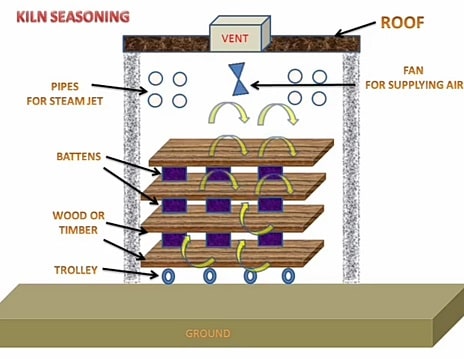
Heated air up to temperature range between 35°C to 38°C and fully saturated with moisture is forced inside the chamber.
Now the relative humidity is gradually reduced. Until the desired degree of moisture content is attained, the temperature is increased and maintained.
According to the construction mode and work mode, the kiln may be grouped into two types, such as stationary kiln and progressive kiln.
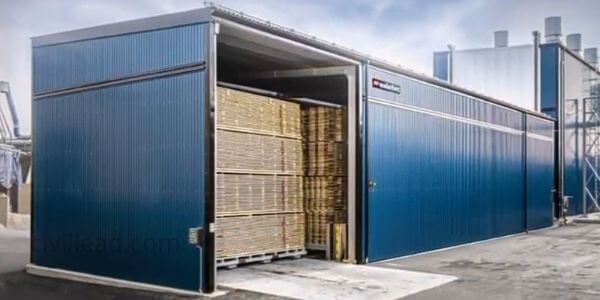
Stationary Kiln – In the Stationary kiln single compartment is used to perform the seasoning process. It is suitable for seasoning timbers, which require close control of temperature and humidity and give better results.
Progressive Kiln – For the extensive seasoning of timbers, this method is adopted. In this method, a carriage with the timbers section slowly travels from one end to another of the kiln.
For keeping the temperature low at the charging end, hot air is provided from the discharging end, and it rises towards the discharging end.
Seasoning by Boiling in Water
Water seasoning can be done by using boiling water. The timber is kept immersed in boiling water for four hours, by this method strength and elasticity of the timber reduced, although there is less shrinkage.
Seasoning by Steaming
This is similar by boiling but the timber dries soon after the steaming. Steaming prevents dry rot in timber, but it is expensive.
Chemical Seasoning
The chemical seasoning is also known as salt seasoning. In chemical seasoning, the timber is immersed in a solution of suitable salts. The interior surface of timber dries in advance of exterior one and chance of formation of external cracks are decreased.
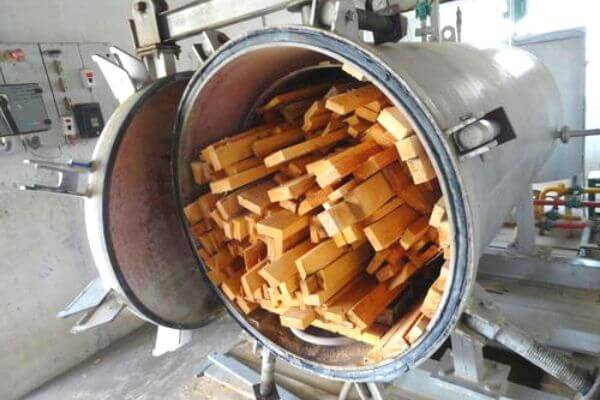
Electrical Seasoning
In this type of seasoning, The high-frequency AC currents are used. The green timber offers less to flow electric resistance currently. As the wood dries internally the resistance raised that also results in the production of heat. This is the most rapid method of seasoning, but higher initial and maintenance costs.
Comparison Between Natural Seasoning and Kiln Seasoning
| S.No. | Item | Natural Seasoning | Kiln Seasoning |
| 1. | Moisture Content to 18% | It is difficult to reduce the moisture content below level. | The moisture content can be reduced to any desired level. |
| 2. | Nature | It is simple and economical. | It is expensive and quite technical. |
| 3. | Quality of timber | The air seasoned timber is more likely to the attack of insects and fungi. | The kiln seasoned timer is less liable to the attack of insects and fungi. |
| 4. | Space | It requires more space for stacking. | It requires less space for stacking |
| 5 | Speed | It is a slow process. | It is quick a process. |
| 6 | Strength | It gives stronger timber. | It gives a little weaker timber. |
Precautions During Seasoning of Timber
Following precautions should be followed during timber seasoning.
- The removal of moisture should be done at maintained environment conditions during seasoning.
- The rate of extraction of moisture should be equal for all the logs because there is the chance of irregular shape due to differentiated dryness.
- During air seasoning, seasoned timber should be protected from high humidity and rain exposure.
- For easy and uniform passing of air and water s a suitable gap between logs should be kept.
Thanks for reading this article. If you find this article helpful Please, don’t forget to share it.
Also, read
Requirements of Good Quality Timber
MDF vs Particle Board – Difference Between MDF and Particle Board.
UPVC Windows Vs Aluminum Windows Vs Wooden Windows
What is ACP (Aluminum Composite Panel)? – Definition, Advantages and Disadvantages
What is WPC Boards? – Advantages, Disadvantages and Uses